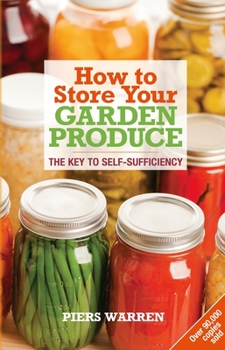How to Store Your Garden Produce: The Key to Self-Sufficiency
Select Format
Select Condition 
Book Overview
Become self-sufficient all year round with this handy guide to storing your garden produce.
Format:Paperback
Language:English
ISBN:190032217X
ISBN13:9781900322171
Release Date:March 2008
Publisher:Green Books
Length:152 Pages
Weight:0.20 lbs.
Dimensions:0.4" x 6.1" x 9.2"
Related Subjects
By Technique Cooking Cooking Gardening Gardening & Landscaping Home & Garden House & HomeCustomer Reviews
5 ratings
good book, some outdated information
Published by Thriftbooks.com User , 14 years ago
I havn't read all of the book yet, but it looks very helpful. I did find one problem though. In the section about canning your food in jars, it mentions using the oven. This process for canning is not safe according to the USDA. It does not heat the food hot enough to kill the bacteria. If you want to can your produce, I recommend visiting the USDA website for up to date recipies and information on safely preserving your food via canning.
A lot of information is in this little book!
Published by Thriftbooks.com User , 14 years ago
If your crisper or garden contains veggies and fruits that rot before you can use them, this little book can save your produce and your wallet money! In the first part of the book you'll find basic storage tips, ways to freeze foods, drying techniques, vacuum-packing strategies, salting, bottling, and recipes for pickling, relishes, jams, jellies, fruit butters, cheeses and more. The second part of the book talks about each vegetable and fruit individually with advice for storage. For instance celery can be left in the ground until needed (past the first frost). The harvested stalks will keep fresh in the refrigerator for days. To keep the celery beyond when it would go bad, the author gives tips for freezing (for stews etc) and then gives a recipe for celery soup. Grapes, on the other hand, can be dried, frozen, or used for juice. The author provides recipes for grape jam, ketchup (yes ketchup), and wine. The recipes for the various fruits and vegetables are varied and most of them appear to be easy to make. I've used the ones for cucumber pickles, applesauce, and the leek and potato soup among others. This is a great little reference book if you are serious about saving your produce from the garbage disposal!
WONDERFUL Resource!!
Published by Thriftbooks.com User , 14 years ago
I LOVE this book!! It is the perfect sized reference book, not to lengthy, but complete in my opinion. The book itself is also a good hand held size which makes it easy to keep tucked close. It's so simple to use, alphabetically I can search for just what I'm looking for, say celery (yes, it can be preserved!), or for how long something, say bell peppers, should be blanched prior to freezing. Just what I need to know without added fluff/filler. This was just what I NEEDED!!
Fantastic for any gardener
Published by Thriftbooks.com User , 15 years ago
Piers Warren starts off with basic instructions for storage methods: clamping (storing large quantities of roots outside) and other methods of dry storage, freezing, drying (from oven to dehydrator), vacuum-packing, salting, bottling/canning, pickling, relishes & sauces, jams & jellies, and fermenting. This volume isn't meant as a full-blown wine-making or jam-making resource, so these are only the most basic instructions. The rest of the book covers individual types of produce in alphabetical order. Since the focus of this book is supporting yourself on your own produce, Warren discusses some topics you might not expect. For instance, how best to harvest a vegetable so as to encourage further harvest throughout the season. He discusses varieties that will have longer harvest times, or that will produce during different times of the year. He talks about how some plants can be started at different times so as to result in a longer harvest period as well. One potentially useful feature is the section of recommended varieties. For example, the apples section lists out two good varieties of cooking apples, a crab apple, and a handful of eating apples, noting which ones keep particularly well or work best for wine-making or the like. However, in some cases this won't be as useful outside of Britain (the book was written & published in Britain but is also being distributed in other countries). For instance, I don't recognize many of the apple or tomato varieties. However, I do recognize a number of the carrot and chard varieties. It just depends on whether a particular type is available & grows well where you are. The one other small potential snag is a couple of terminology issues. Most of them aren't a big deal (what US readers call canning, Brits call bottling, but the author notes this). One or two types of produce might be listed under a name unfamiliar to you (plenty of people have heard eggplants called aubergines, but not everyone in the US knows them by that term). Don't let this deter you from buying this book if you're in the US, however---the information is incredibly useful, and in most cases there are enough informative notes included that you can substitute varieties as appropriate or easily figure out the terminology differences. Also, all measurements for recipes and such are given in both metric and English measurements. If you want to become more self-sufficient, or you just want to make better and less wasteful use of your garden produce, I definitely recommend this book.
Excellent Reference Book
Published by Thriftbooks.com User , 18 years ago
This unusual book saves so much time trawling through all my old gardening books looking for storage techniques for various vegetables and fruit. I use it a lot and have also given it to friends as presents and they are very pleased too! Highly recommended.





